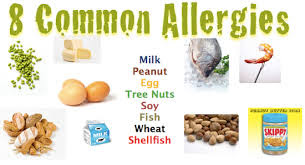There
are plenty of children across the world that deal with food allergies. Living with them can be a huge hassle for the
parents to work around, depending on the allergy. According to KidsWithFoodAllergies.org, the
most common allergies are milk, eggs, peanuts, soy, tree nuts, wheat, fish, and
crustacean shellfish (2017). This
website contains lots of helpful facts, recipes, tips and tricks, and support
for kids with food allergies and the different aspects of life it may affect.
Peanut allergies are very common to
hear about kids growing up with especially in elementary schools. According to the website, “approximately 0.6%
of American children have a peanut allergy” (2017). This means that those children are at an
increased risk for fatal or near-fatal reactions. Anything that has had traces
of peanut in or on it could set of a reaction.
Therefore, kids with this allergy need to have a diet that is firmly
guarded and inspected before consumed.
The Food Allergen Labeling and
Consumer Protection Act requires that all foods with peanut ingredients or
traces of it require the label to read “Contains Peanuts” somewhere visible
(2017). KidsWithFoodAllergies.com has a
nice long list of foods that contain peanut, and may contain peanut in
them.
Egg allergy is another common one in
kids. The same protection act requires ingredient labels to state “Contain: Egg”
on them to inform consumers of what they are buying. Interestingly enough, the egg white is the
part of the egg that triggers an allergic reaction (2017). Eliminating eggs may also mean that another
source of protein may be needed if they are eliminated as an option and are
often times a go-to source in many households.
The following foods are good substitutes for eggs:
- Milk
- Meat
- Poultry
- Nuts
- Legumes
The next common allergy is
wheat. Sometimes people get a wheat
allergy mixed up with Celiac Disease.
According to KidsWithFoodAllergies.org, Celiac Disease is an autoimmune
disorder whereas wheat allergy is an instant reaction to wheat within the body.
Celiac Disease is where someone cannot
have gluten or else their body would respond negatively by damaging the small
intestine (2017). Cross-contamination is a major concern for this category of
allergy since so many foods are made with wheat nowadays. A good list of foods
to avoid is also found on the same website.
Lastly, a milk allergy is often
found among American children today.
This allergy is especially tough because there are so many different
kinds and forms of milk that it’s hard to remember and know all of them. Even foods like cheese, pudding and yogurt
all contain milk, although they aren’t usually the first things that pop into
mind when thinking of a “milk” allergy. This
is not the same as lactose intolerance, since that is when the body simply can’t
digest lactose found in milk products (2017). The
same protection act requires the labeling of “nondairy” or “milk” to be listed on
the label of a product if it’s present in the ingredients. Some common milk
alternatives may be: Soy milk, fortified milk, coconut milk, or nut milks
(2017).
Tips, a video, and more information on common food allergies is available at the following link from Med-Health.net: http://www.med-health.net/Common-Food-Allergies.html
Tips, a video, and more information on common food allergies is available at the following link from Med-Health.net: http://www.med-health.net/Common-Food-Allergies.html
For school-age children, it is
especially important for them to be educated on their allergy so they know what
to avoid and can be their own health advocate. Knowing what they can and can’t eat could make
the difference in their safety, and could avoid a potential trip to the
hospital.
References
Living with food allergies. (2017). KidsWithFoodAllergies.org. retrieved from: http://www.kidswithfoodallergies.org/page/living-with-food-allergies.aspx

No comments:
Post a Comment